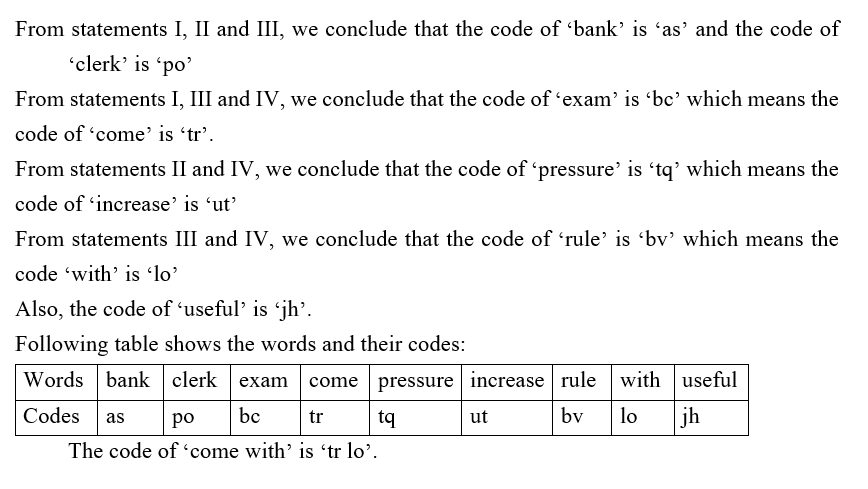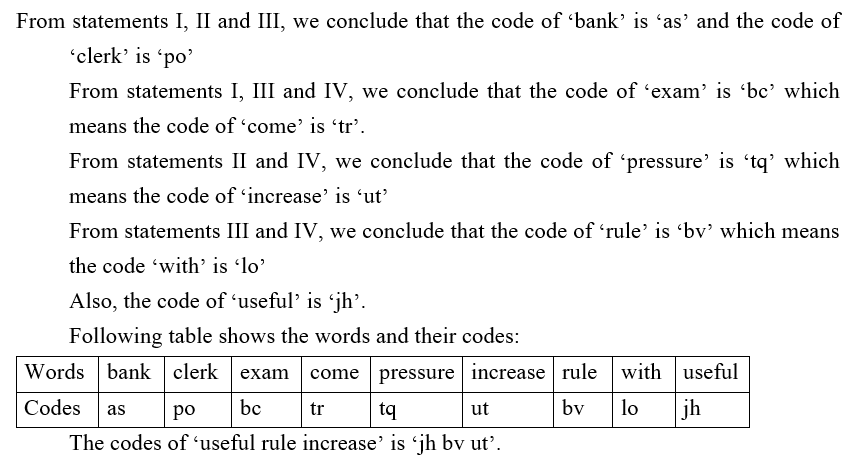Question 1:
Directions : Study the following arrangement of numbers, symbols and letters carefully and answer the questions:
निर्देश : दिए गए संख्या, प्रतिक और अक्षर के व्यवस्था का ध्यानपूर्वक अध्ययन करें और सवालों के उत्तर दें।
6 X # K + 5 L 4 D > T G 7 $ 1 A @ Q 2 E % B 3 U & 8 R * 9
In the given arrangement, how many such numbers are there which are immediately preceded by a letter?
दिए गए व्यवस्था में, ऐसे कितने संख्या हैं जिनके तत्काल पहले एक अक्षर है?
Question 2:
Directions : Study the following arrangement of numbers, symbols and letters carefully and answer the questions:
निर्देश : दिए गए संख्या, प्रतिक और अक्षर के व्यवस्था का ध्यानपूर्वक अध्ययन करें और सवालों के उत्तर दें।
6 X # K + 5 L 4 D > T G 7 $ 1 A @ Q 2 E % B 3 U & 8 R * 9
In the given arrangement, how many odd numbers are between “L” and “%”?
दिए गए व्यवस्था में, "L" और "%" के बीच कितने विषम संख्या है?
Question 3:
Directions : Study the following arrangement of numbers, symbols and letters carefully and answer the questions:
निर्देश : दिए गए संख्या, प्रतिक और अक्षर के व्यवस्था का ध्यानपूर्वक अध्ययन करें और सवालों के उत्तर दें।
6 X # K + 5 L 4 D > T G 7 $ 1 A @ Q 2 E % B 3 U & 8 R * 9
If all the symbols and numbers are dropped from the given arrangement, which element is 7th to the left of 4th element from the right end?
यदि दिए गए व्यवस्था से सभी प्रतिक और संख्या को हटा दिया जाता है, तो दाएँ छोर से चौथे तत्व के बाएं से सातवां तत्व कौन सा होगा?
Question 4:
Directions : Study the following arrangement of numbers, symbols and letters carefully and answer the questions:
निर्देश : दिए गए संख्या, प्रतिक और अक्षर के व्यवस्था का ध्यानपूर्वक अध्ययन करें और सवालों के उत्तर दें।
6 X # K + 5 L 4 D > T G 7 $ 1 A @ Q 2 E % B 3 U & 8 R * 9
In the given arrangement, how many symbols are there between “D” and “B”?
दिए गए व्यवस्था में, "D" और "B" के बीच कितने प्रतिक है?
Question 5:
Directions : Answer the questions based on the information given below.
निर्देश : नीचे दी गई जानकारी के आधार पर प्रश्नों के उत्तर दें।
U B # 3 O 2 L V * & M 6 7 P D F ^ 8 C W ? @ A 9 1 X
If all the symbols are dropped then which element is third to the right of seventh element from right end?
यदि सभी प्रतीकों को हटा दिया जाए कौन-सा तत्व दाएं छोर से सातवें तत्व के दाएं से तीसरे स्थान पर होगा?
Question 6:
Directions : Answer the questions based on the information given below.
निर्देश : नीचे दी गई जानकारी के आधार पर प्रश्नों के उत्तर दें।
U B # 3 O 2 L V * & M 6 7 P D F ^ 8 C W ? @ A 9 1 X
How many symbols are between 2nd number from left and 3rd number from right?
बाएं से दूसरी संख्या और दाएं से तीसरी संख्या के बीच कितने प्रतीक हैं?
Question 7:
Directions : Answer the questions based on the information given below.
निर्देश : नीचे दी गई जानकारी के आधार पर प्रश्नों के उत्तर दें।
U B # 3 O 2 L V * & M 6 7 P D F ^ 8 C W ? @ A 9 1 X
How many vowels are to the left of C?
C के बाएं ओर कितने vowels हैं?
Question 8:
Direction : Answer the questions based on the information given below.
निर्देश : नीचे दी गई जानकारी के आधार पर प्रश्नों के उत्तर दें।
In a certain code of language, एक निश्चित कूट भाषा में,
I. ‘bank clerk exam come’ is coded as ‘as bc po tr’
I. ‘bank clerk exam come’ का कूट है 'as bc po tr'
II. ‘pressure clerk increase bank’ is coded as ‘po ut tq as’
II. ‘pressure clerk increase bank’ का कूट है 'po ut tq as'
III. ‘with exam bank rule’ is coded as ‘bv bc as lo’
III. ‘with exam bank rule’ का कूट है 'bv bc as lo'
IV. ‘pressure rule exam useful’ is coded as ‘tq jh bc bv’
IV. ‘pressure rule exam useful’ का कूट है 'tq jh bc bv'
What is the code of ‘come with’?
‘come with’ के लिए क्या कूट है?
Question 9:
Direction : Answer the questions based on the information given below.
निर्देश : नीचे दी गई जानकारी के आधार पर प्रश्नों के उत्तर दें।
In a certain code of language, एक निश्चित कूट भाषा में,
I. ‘bank clerk exam come’ is coded as ‘as bc po tr’
I. ‘bank clerk exam come’ का कूट है 'as bc po tr'
II. ‘pressure clerk increase bank’ is coded as ‘po ut tq as’
II. ‘pressure clerk increase bank’ का कूट है 'po ut tq as'
III. ‘with exam bank rule’ is coded as ‘bv bc as lo’
III. ‘with exam bank rule’ का कूट है 'bv bc as lo'
IV. ‘pressure rule exam useful’ is coded as ‘tq jh bc bv’
IV. ‘pressure rule exam useful’ का कूट है 'tq jh bc bv'
‘po tq’ are code for __ and ___?
'po tq' __ और ___ के लिए कूट हैं?
Question 10:
Direction : Answer the questions based on the information given below.
निर्देश : नीचे दी गई जानकारी के आधार पर प्रश्नों के उत्तर दें।
In a certain code of language, एक निश्चित कूट भाषा में,
I. ‘bank clerk exam come’ is coded as ‘as bc po tr’
I. ‘bank clerk exam come’ का कूट है 'as bc po tr'
II. ‘pressure clerk increase bank’ is coded as ‘po ut tq as’
II. ‘pressure clerk increase bank’ का कूट है 'po ut tq as'
III. ‘with exam bank rule’ is coded as ‘bv bc as lo’
III. ‘with exam bank rule’ का कूट है 'bv bc as lo'
IV. ‘pressure rule exam useful’ is coded as ‘tq jh bc bv’
IV. ‘pressure rule exam useful’ का कूट है 'tq jh bc bv'
What is the code of ‘useful rule increase’?
‘useful rule increase’ के लिए कूट क्या है?



